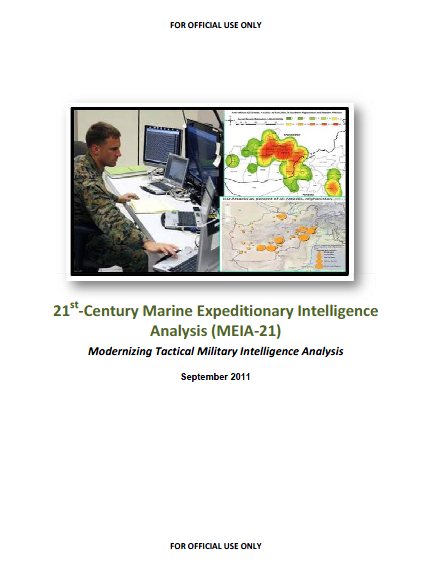21st‐Century Marine Expeditionary Intelligence Analysis (MEIA‐21) Modernizing Tactical Military Intelligence Analysis
- 20 pages
- For Official Use Only
- September 2011
21st‐Century Marine Expeditionary Intelligence Analysis (MEIA‐21) is a formal initiative to structure, standardize, and professionalize tactical intelligence analysis in the Marine Corps. It professionalizes Marine expeditionary intelligence, equipping intelligence analysts with analytically rigorous Structured Models, Approaches, and Techniques (SMATs)—applied tradecraft—to provide commanders with actionable, reliable tactical intelligence in conventional and irregular warfare while also instilling the cognitive and creative skills to create and refine that tradecraft.
…
Core Principles of MEIA‐21
MEIA‐21 is the process of building analytic modernization on six foundational principles:
1. Successful operations require reliable tactical intelligence. Operations are command led and intelligence fed.
2. Reliable tactical intelligence is achieved through structured, mission‐specific applied
tradecraft.– Tradecraft is the SMATs that analysts use to develop actionable intelligence from raw data.
– SMATs originate from field‐derived, experiential learning by Marine intelligence analysts.
– Foundational skills, such as Structured Analytic Techniques (SATs), und0erlie the development and application of mission‐specific tradecraft.3. Tradecraft‐driven intelligence analysis is conducted using analytically rigorous processes.
– Marine Corps intelligence analysis must move beyond a reliance on raw intuition and readily available information to scientifically valid, objective techniques.
– Processes and tools (SMATs) must be vetted for analytic rigor, formalized, documented, and taught.
– Sustainable analytic rigor requires ongoing critical review and continuous improvement of tradecraft.4. Social Science Intelligence (SSI) is essential for successful intelligence analysis in COIN and other nonconventional operations. It also is critical for conventional operations.
– Without structured consideration of social factors, our knowledge of human‐centered problems is subjective, unscientific, overly informed by raw intuition, and less reliable.
– SSI uses structured models, approaches, and techniques based upon proven principles and practices from economics, political science, anthropology, and other disciplines that study human behavior.
– Applied social science is an important way to develop understanding (insight and foresight) in the context of operational requirements.5. In an era of enormous quantities of potentially useful data, technology is critical to intelligence work.
– People—not tools—perform analysis, but machine‐aided analysis can help analysts organize, store, and cut through massive amounts of data to discover the nonobvious and unseen and to identify otherwise invisible patterns.
– Technology empowers analysts to archive, organize, discover, and retrieve information for near‐real‐time analysis.
– Models and tools not only save time and cognitive energy, they correct fallible human senses and intuition that, left unaided, may misrepresent reality or distort analysis.6. Intelligence analysis is a profession and should be structured as such.
– Mastery of tradecraft, not job title, defines the profession of Marine Corps intelligence analysis.
– Marine intelligence analysts must have a deep knowledge of tradecraft. Area expertise is valuable, but inadequate to develop actionable intelligence or reliable knowledge in the absence of structured applied tradecraft.
– Structured tools, methods, and processes must be disseminated and institutionalized through formal training, standards, and continuing education. Intelligence analysts should be certified in the practice of their profession.…
Social Science Intelligence and the New Analytic Environment
Marine Corps warfighting has primarily been based on the capability to find, fix, and strike the enemy force. To support this, Marine Corps tactical intelligence was often kinetics‐based, target‐centric, and optimized for producing intelligence against conventional military formations. Adversaries were well defined, providing a relatively sharp focus for intelligence. But 10 years of operations in Iraq and Afghanistan have repeatedly shown that armed groups confronting Marines today avoid U.S. targeting superiority by operating asymmetrically within congested and cluttered environments. Contending with conventional, counterinsurgency (COIN), and nonconventional operations in the upcoming decades of the 21st century, Marines will once again be exposed to socially complex environments and hybrid armed groups. Many of these threats (conventional and nonconventional) and adversaries (state, state proxies, and nonstate actors) will be more agile, less visible, and possess an information advantage where it is easier for them to see and target us than for us to see and target them.
Given this operational environment, the MCISR‐E must analyze more than an adversary’s characteristics and capabilities. Expeditionary intelligence must incorporate the context within which adversaries operate; the institutions within which they live; and their fears, perceptions, and motivations; in short, we must consider the totality of the human sphere.
This new approach to intelligence analysis, focusing on understanding human social organization is called Social Science Intelligence (SSI). There has been significant growth in the techniques and technologies of intelligence analysis, especially in the social sciences such as economics, political science, anthropology, and other disciplines relating to the study of human behavior. Because the most advanced knowledge in these fields is dispersed within academia and not directly focused on intelligence‐related problems, it’s hard to access and consequently plays an inadequate role in tactical intelligence today—Marine intelligence analysts’ knowledge of human‐centered problems tends to be subjective, unscientific, technologically weak, and based mostly on the raw intuition and personal experience of the individual analyst.
The challenge is to develop, refine, and deploy applied techniques that enable us to understand the totality of the human domain framework with speed and precision. An analytic modernization plan that captures critical best practices, leverages the best social and physical science know‐how available, and makes available sophisticated analytic instruments that analysts can readily apply to intelligence problems is critical to success. When made available, these methods and approaches give analysts social and physical science expertise from the fields that parallel the questions faced by intelligence (e.g., accounting, organizational theory, elite analysis, political science, economics, and census/registry).

